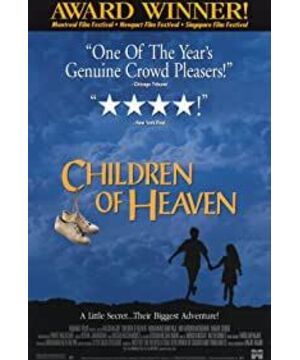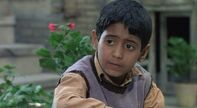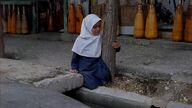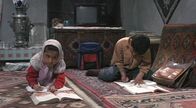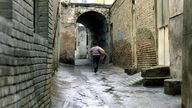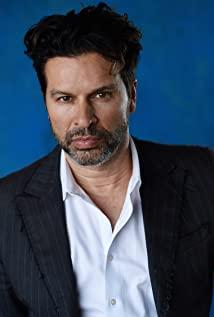It should have been a theoretical assignment of film aesthetics, but it was not utilitarian enough, and I was not familiar with films, so I could only write a film review. . .
"Little Shoes" (aka Children of Heaven) is like a line of poetry. The film tells the story of two intelligent and kind-hearted brothers and sisters from the bottom family in Iran, who endured the hardships of life early and experienced the hardships of reality. The film starts with the story of a pair of small shoes. Brother Ali accidentally lost his sister's only pair of shoes when he was helping his sister Sarah go out to repair shoes. In order not to be blamed by their parents and increase the burden on the family, the two brothers and sisters agreed that the younger sister would wear shoes to school in the morning and then run home for the older brother to go to school. The rhythm of the story is slow but full of warmth, and there is no lack of suspense in the bland narrative, showing the kindness and innocence of children's world that is still maintained under the poor and difficult civilian life in Iran. Although the film is narrated from the perspective of children, it has consistently inherited the characteristics of previous Iranian children's films: the description of children's psychology is a projection of the adult world, showing the audience Iran's social, religious, political and Ideology conveys the values of maintaining goodwill in suffering, and uses poetic film language as a drizzle to nourish the hearts of viewers.
1. Realistic and poetic visual language
"Little Shoes" is a very typical Iranian movie. Unlike the dazzling scenes of Hollywood movies, the pictures and narratives of Iranian movies are simple and poetic. Director Majid Majidi uses natural light, uses real scenes, uses a lot of realistic long shots and close-ups, and arranges non-professional actors to reproduce a simple but infectious life story, which makes the whole film poignant and poignant. Tenderness complements each other.
Little Shoes jumps right into a 2-minute close-up right from the start. A pair of old hands is probably a shoe repairer repairing a shoe. The shoe is a purple children's model with a bow. The upper is very clean. The owner has kept it well, but the sole is worn out. This long shot seems to point to the title of the movie, Little Shoes, but in fact, from a pair of worn-out shoes we see that the owner of this pair of shoes is experiencing the burden of a poor life. In addition, it also caused the audience to think about the long-term close-up of the shoes: what kind of story will unfold about this pair of shoes?
Because the theme of the shooting is shoes, the audience will see many shots of people walking shoes from above. In order to ensure the authenticity of the scene, most of the shots are taken from the audience's perspective, resulting in a lot of shaky shots, but in In the arrangement of the plot, these scenes are when the younger sister sees her shoes on the feet of other girls and becomes suspicious and emotional, so the shaking camera shows the complex mood of the protagonist to the viewer.
In addition, there are many running scenes in the film. The fact that running is a plot set up by the younger sister and the elder brother to catch up with changing shoes also paved the way for the narrative that the elder brother Ali participated in the running competition for the third runner-up shoe prize but won the championship. We can see that the running scene of the elder brother and sister is relatively fixed. The aspect is to show that the two are running on the same road, which will not clutter the scene. The camera is different from the usual sports shots. The running is shot with a fixed camera. When running, the camera is mostly fixed, and the actor runs from one side of the screen to the other side, which can cause confusion as well as produce Anticipation: Where is the next scene where the character will run.
In addition to using the lens to express the film's realistic visual language, the film also shows a poetic use of natural light. "Little Shoes" has very few lighting parts. In order to express the camera and ensure the authenticity of the scene, the viewer's eyes are focused on the narrative of the story. It can be seen that most of the movies use natural light, and they are good at using natural light in large areas. Rich changes in nature, such as tree shadows in natural light, sparkling light reflected in water. In the film, the father and Ali went to the big city together to trim the gardens for the residents in the villa. On the way home after earning money, they rode their bicycles home in the shadow of a tree. The shadows of the trees are completely blocked, indicating that the brakes of the bicycle will fail. The two fell from the car. The father was seriously injured, which made the family more difficult.
At the end, Ali, who was trying hard to win the prize shoes for the third place but regretted winning the championship, took off his socks and put his blistered feet in the water after running - because there were no suitable sneakers, there was only one pair that he and his sister now wear in turn. old canvas shoes. When he was sitting in the pool, looking down at Ali from the camera, under the sunlight, the water on the side of Ali was glowing with water, the shimmering water was as dazzling and calm as diamonds, just like this kind-hearted At this moment, the children are shining and admirable in the minds of the viewers.
2. Metaphors for constructing children's world
Although "Little Shoes" always uses realistic shooting techniques to reproduce real social life, the film cannot guarantee the absolute objectivity of the scene like a documentary, as Pasolini pointed out in "Poem's Film": It is essentially a new language." A film director must first create the vocabulary he needs, that is, take his subjects and create them as his own figurative symbols, and then enter into the creation of beauty. [①] In "Little Shoes", director Majid Majidi used the lens to select two brothers and sisters at the bottom of society and the Iranian civilian society, and reproduced Iran's life experience, religious belief and humanistic care through different visual symbols. lower social family.
The image of the shoes that tie the story together. Among them, the small shoes not only connect the entire narrative line of the film, but also an important clue of meaning in the film. The shoes of many different characters have different plot roles in the film. The older brother loses his younger sister's shoes and turns up on other people's feet, the older brother and younger sister exchange older brother's old shoes for commuting to and from school, new shoes appear in mall windows and black-and-white televisions, and finally, a hint that father buys for both brother and sister new shoes. In these shoes that have a role in promoting the plot, they are used as movie props, but this movie prop represents the three meaning clues of "poverty-dream-hope" respectively. The beginning is a 2-minute close-up of a pair of red shoes. It can be seen that the shoes are so tattered that they cannot be worn, but they are still being mended by the shoemaker. The shoes are very tattered but need to be repaired, which symbolizes the poverty of the shoe owner. Different shoes have different meanings. My brother's shoes contain the innocence and innocence of the two children, and the shoes have been photographed in the later lens to represent the girl's mood changes because the shoes are not good-looking and do not fit well. The new shoes in the window, the advertisements for shoes on TV, and the new shoes bought by the father also symbolize different characters for the characters.
A child's dream life under a bad life and destiny. From the young child actor's point of view, the poverty and hardships of life seem to lighten the viewer's experience of suffering. In fact, the two little protagonists in the film always face the hardships brought by real life. In the beginning, the elder brother helped the younger sister to repair shoes, went out to buy food, and had to take credit at the store because he could not pay the rent; the elder brother and his father went to work in the wealthy area with children of the same age; participated in the marathon wearing tattered shoes and won shoes for the younger sister, etc. etc., the director's construction of the brothers and sisters in the real life of the film is a world full of suffering, injustice, poverty, and class differences, just like those we are experiencing or will experience in real life. Different from the real world experienced by the two brothers and sisters in the movie, what they experience in their hearts is a heavenly world. The small shoes that were repaired at the beginning of the film had torn soles, but they were indeed pink and fuchsia shoes with bows. In the middle of the film, the younger sister accidentally dropped her shoes into the ditch while they were running. When the brothers and sisters washed shoes together, they used washing powder to blow bubbles, and colorful soap bubbles surrounded them, showing the child's naughty nature in laughter and laughter. This is the interpretation of their inner feeling of happily wandering in heaven. At the end of the film, Ali won the championship but missed the prize for the third place - the sneakers Song gave to his sister, took off the shoes that were broken, and put his feet full of blood blisters into the pool, and those in the pool The red goldfish kissed his feet as if inspired. Just like another movie translation, they are children in paradise living in a fairy tale world, and they are the representatives of pure and innocent children. The director said in an interview: "Goldfish is an important element in Iranian culture, representing life and vitality. In Iranian New Year ceremonies, we all set the table of seven immortals, one of which is goldfish. Put goldfish in the film This kind of good wishes is also sustenance.” [2] The children’s world constructed by the director is precisely in the bottom-level families who are experiencing hard life just like the suffering in reality, and the hearts of children who are still innocent, pure and beautiful. Life. Ali and Sarah represent kind, intelligent, beautiful, and responsible angel-like children. This is also the way the director shows through the perspective of children that the weak and poor civilians of the Iranian people are still positive and optimistic despite the suffering of life. Spiritual, adult society full of humanistic care.
3. Adult society reflected by children's world
Just as Iranian children's films enjoy a high reputation in the international perspective, on the global film stage, and form the stereotype of Iranian children's films, it is precisely because Iranian children's films are not defined by the level of intelligence, or in naive language. Like an educational film that preaches to viewers, it contains rich philosophy in simple stories. It is suitable for children's viewing, conveying positive values to them, and also allowing viewing adults to communicate with society in the world of children. Director Majid Majidi once said: "Children's world is very pure and colorful, their world can have an impact on the adult world, their perspective and information will be transmitted to the adult world to a large extent, their beliefs It is also very firm and powerful. Therefore, many of the stories I tell are mediated by children and adolescents.” [③] In other words, children are the director as a medium to communicate between adults and society.
So how do Ali and Sarah in the film think about poverty, class disparity, the injustice of life and the injustice of life? "Little Shoes" is to answer the questions of "adults" through the little things about shoes of brothers and sisters. It can be seen that the two little protagonists have always maintained kindness and tolerance in the story. When the younger sister and older brother knew that the shoes were on the feet of a little girl whose life was more difficult, and when they learned that the little girl's blind father picked up the shoes unintentionally, the younger sister and older brother chose to remain silent and understand. In fact, apart from the two kind-hearted protagonists, most of the supporting characters that my brother and sister met who played very little time were mostly kind and friendly people who helped them, such as the kind-hearted people who helped my sister pick up the shoes that fell in the sewers, my brother The kind employers I met while working in the city with my father, etc.
The turning points of the stories in the film are all the blows of fate to the poor family in the film. In the face of poverty and difficulties in life, the brothers and sisters have always maintained a kind heart to look at the world. , and therefore they know tolerance, sympathy and gratitude. These qualities are the most intuitive feelings the film brings to the audience. "Little Shoes" uses the most brief story to elucidate the grand theme, that is, the shared feelings and emotions of people across races and regions. This is also the conclusion of children's stories. Thinking about economy, religion, culture, etc. So the reason why the movie is concerned and welcomed by the world as a children's film.
One of the themes to be expressed in the film is to tell us to have a pair of "pure eyes" when looking at some issues. Looking at the world from the perspective of children, in the eyes of children, the world is pure white and flawless, just as Mr. Feng Zikai advocated that adults can see the beauty of this society and the world with innocent eyes, and express their childhood feelings. I believe that even when we encounter some problems, we can bring love and kindness to others like the kind passers-by who help others in the film.
In addition, "Little Shoes" is also a bridge to understand Iranian customs and religious culture. As an ancient civilization that believes in Islam and takes religion as its absolute dominance, Iran has an absolute influence on Iranian films. On the one hand, Iranian films are subject to strict censorship, and Iranian directors have to "dance in shackles", so the creation under shackles brings a different kind of poetry. On the other hand, religion has become an inescapable and evasive content of Iranian films. In the film, the father is helping the mosque crush sugar. Even if there is no sugar at home, he will not take any sugar. His education to the children is that no matter how poor they are, they cannot take things that are not theirs. In another scene, the father offered sugar to Allah in tears and prayed, hoping that his piety could be protected by Allah. In addition to religion, the film also shows the unique social customs of Iran and the daily habits of civilians. The Iranian country attaches great importance to family education and the unity and harmony between members. The promotion of the story in "Little Shoes" is that Ali does not want to aggravate it. The burden of the family and the sense of responsibility as a brother and a member of the family, and the images of the protagonists' father and mother in the story represent the parents of Iran. In the film, the father and mother care for and educate their children, while the two little protagonists are full of love. Kindness and a sense of responsibility are seen in the film as both fathers and mothers attach importance to their family education. Therefore, under the circumstance of limited film censorship, another aspect of the rise of children's films in Iran is also because the Iranian people know how to attach importance to the national education of children, show the good qualities of children through films, and cultivate a new generation of Iranian children. successor.
4. Summary
The film comes to an abrupt end with Ali's guilt that he didn't win a prize for his sister, but the god-like audience resonates with him in an episodic scene that the audience knew in advance in the sadness and joy that the father buys for the siblings. new shoes. This tragicomic contrast is full of romantic and poetic feelings. As the whole film brings us, "Little Shoes", as a representative work of Iranian children's films, presents to the world audience with a realistic and poetic visual language. It presents a story of children's world, who still maintain kindness and love in the suffering of the bottom social life. The director Majid Majidi creates his own image symbols by selecting the subjects to be photographed, reflecting today's adult society in the children's world, and framing the religion, culture, social customs and national characteristics that traverse Iran. While bringing joy and subtle values to children, it heals adults who have sunk and struggled in misery with the purest group, and spreads the spirit of Iran's national culture. As the most typical representative of Iranian children's films in the film An indelible stroke in history.
references:
[1] Dai Jinhua. Film Theory and Criticism [M]. Beijing: Peking University Press, 2007.
[2] Majid Majidi, Wang Yiwen, Geng Jingjing. The true meaning of children's films and the mission of film art - an interview with Majid Majidi [J]. Film Art, 2019(04): 66-70.
[3] Wang Xia. Children's world and cultural implication in Majid Majidi's films [J]. Film Literature, 2020(04):79-83.
View more about Children of Heaven reviews


